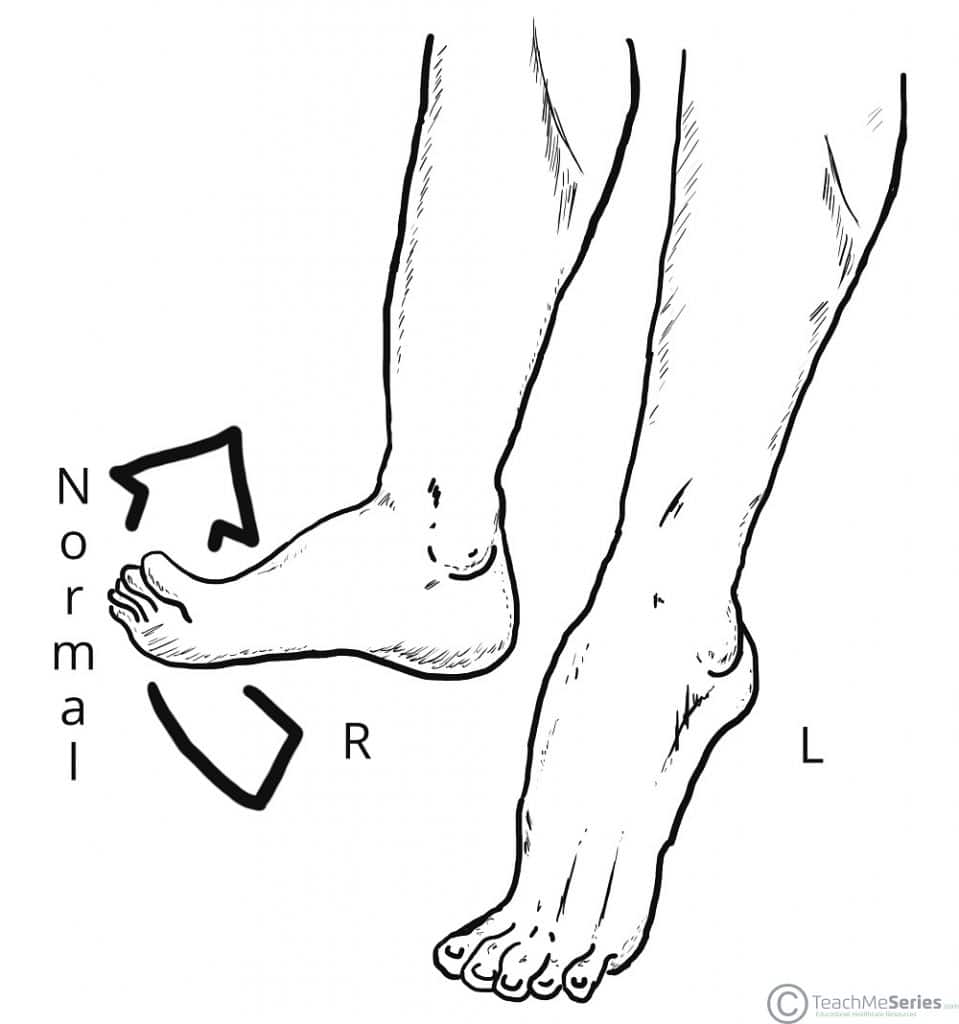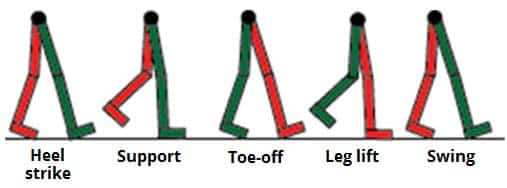Locomotion is the ability to move from one place to another. In humans, walking upright, or bipedally, is the most common method of locomotion.
Walking involves all the joints of the lower limb and is characterised by an ‘inverted pendulum’ motion, in which the body vaults over the non-moving limb.
In this article, we will describe the various stages of walking and the muscle involvement during each stage. We will conclude by looking at some abnormal gaits and discussing the pathologies they demonstrate.
Stages of Walking
The typical walk consists of a repeated gait cycle. The cycle itself contains two phases – a stance phase and a swing phase:
- Stance phase: Accounts for 60% of the gait cycle. It can be divided into the heel strike, support, and toe-off phases.
- Swing phase: Accounts for 40% of the cycle. It can be divided into the leg lift and swing phases.
We will now work through each individual stage in turn, discussing them in more detail.
Heel-Strike
In the heel-strike stage, the foot hits the ground heel first. Three muscles/muscle sets are involved, each acting at a different joint:
- Gluteus maximus – acts on the hip to decelerate the forward motion of the lower limb.
- Quadriceps femoris – keeps the leg extended at the knee and the thigh flexed at the hip.
- Anterior compartment of the leg – maintains the ankle dorsiflexion, positioning the heel for the strike.
Support
After the heel strike stage, the rest of the leading foot hits the ground, and the muscles work to cope with the force passing through the leg. This is known as the support stage.
- Quadriceps femoris – stabilises the knee in extension, supporting the weight of the body.
- Foot inverters and evertors – contract in a balanced manner to stabilise the foot.
- Gluteus minimus, gluteus medius and tensor fascia lata – abduct the lower limb. Their contraction keeps the pelvis level by counteracting the imbalance created from having most of the body weight on one leg.
Toe-Off
In the toe-off phase, the foot prepares the leave the ground – heel first, toes last.
- Hamstring muscles – extends the thigh at the hip.
- Quadriceps femoris – maintains the extended position of the knee.
- Posterior compartment of the leg – plantarflexes the ankle. The prime movers include gastrocnemius, soleus and tibialis posterior.
Leg Lift
Once the foot has left the ground, the lower limb is raised in preparation for the swing stage.
- Iliopsoas and rectus femoris – flexes the thigh at the hip, driving the knee forwards.
- Hamstring muscles – flexes the leg at the knee joint.
- Anterior compartment of the leg – dorsiflexes the ankle.
Swing
In the swing phase, the raised leg is propelled forward. This is where the forward motion of the walk occurs.
- Iliopsoas and rectus femoris – keep the thigh flexed at the hip, resisting gravity as it tries to pull the lower extremity down.
- Quadriceps femoris – extends the leg at the knee, positioning the foot for landing.
- Anterior compartment of the leg – maintains ankle dorsiflexion so that the heel is in place for landing.
Next, the heel hits the ground, and the whole cycle repeats.
Clinical Relevance: Characteristic Gaits
Trendelenburg Gait
During the leg lift and swing phases of walking, the body weight is placed on one limb. The key abductor muscles (the gluteus medius and gluteus minimus) contract to stop the pelvis dropping towards the raised leg, as gravity would otherwise dictate.
A patient with malfunctioning hip abductors will present with a positive Trendelenburg sign: their pelvis drops towards the side of the raised limb. The positive sign signifies that the abductor muscles on the standing limb are weakened or paralysed. For example, if the left leg was raised, and pelvic drop was observed on that side, the abductor muscles on the right leg are the cause. The injury can either be neurogenic (in which the superior gluteal nerve is damaged) or myogenic (in which the muscle fibres are stretched or weakened but the nerve remains functional). A myogenic cause can be addressed with muscle strengthening exercises and physical therapy; a neurogenic cause is more difficult and sometimes impossible to treat.
During walking, a weakness in the abductor muscles gives rise to a characteristic gait. As the pelvis drops on one side, the trunk lurches to the opposite side, in an effort to maintain balance.
During the next step, the trunk is whipped back over the pelvis towards centre. Often the momentum of this is too much for the abdominals, causing the trunk to overcompensate and fall slightly past centre to the opposite side. This highly recognisable lurching walk is called the Trendelenburg gait.
Footdrop
Footdrop is another characteristic gait, which is caused by damage to the common or deep fibular nerve. The common fibular nerve wraps around the head of fibula, so blunt trauma or fracture here can lead to foot drop.
The deep fibular nerve innervates the muscles in the anterior compartment of the leg. These muscles dorsiflex the foot, which is required during the swing phase to clear the toes away from the ground.
If the deep fibular nerve is damaged, then the foot cannot be dorsiflexed, and drags along the ground during the swing phase. To compensate for the lack of dorsiflexion during the swing phase, the patient may evert the foot in a sudden motion, called an ‘eversion flick’.
Another common compensatory movement is hyperflexion of the thigh at the hip to help the dropped foot clear the floor, known as “high steppage gait.”

Fig 3 – Left footdrop. This can occur following common fibular or deep fibular nerve palsy.
Antalgic Gait
An antalgic gait is a gait that results from pain on weight-bearing. It is characterised by a shortened stance phase and is most commonly seen in patients with chronic musculoskeletal pain.
